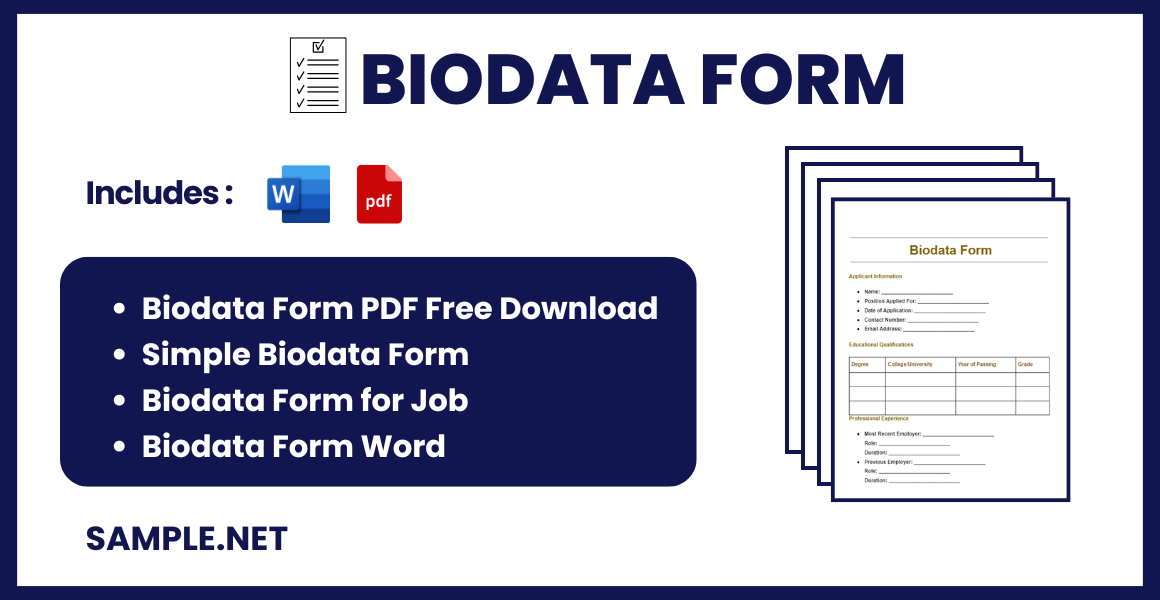Biodata Form Samples
-
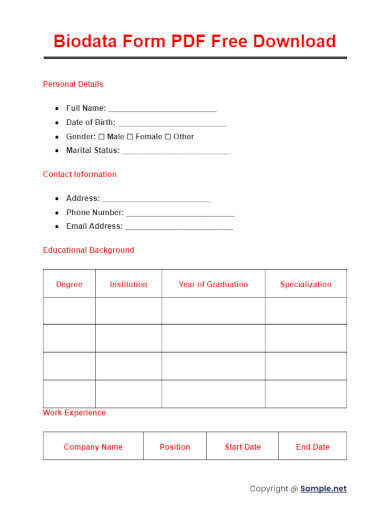
Biodata Form PDF Free Download
download now -
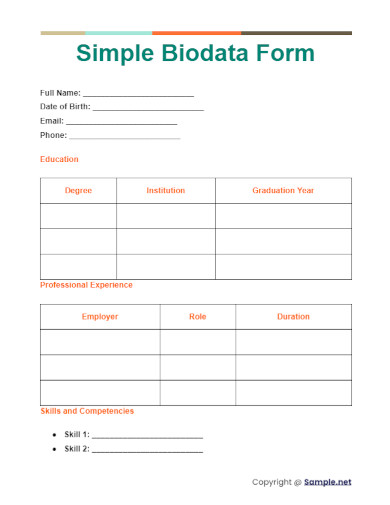
Simple Biodata Form
download now -
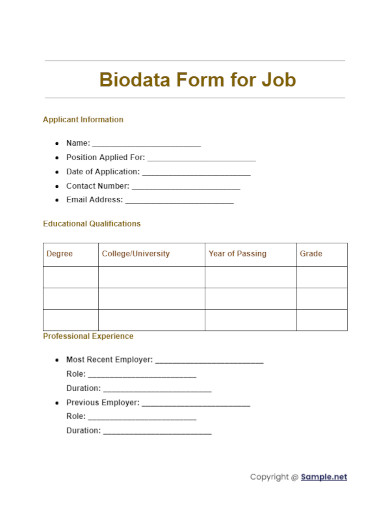
Biodata Form for Job
download now -
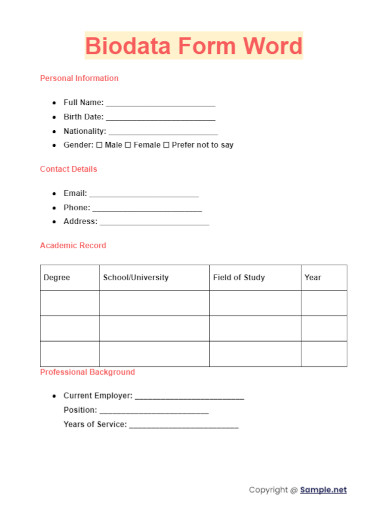
Biodata Form Word
download now -
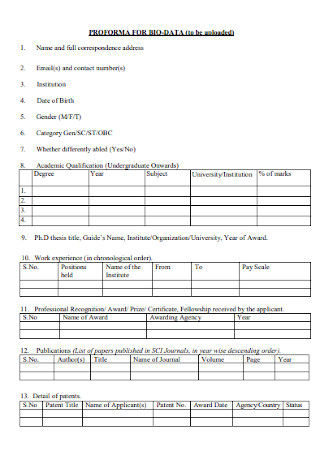
Sample Proforma for Bio Data Form
download now -
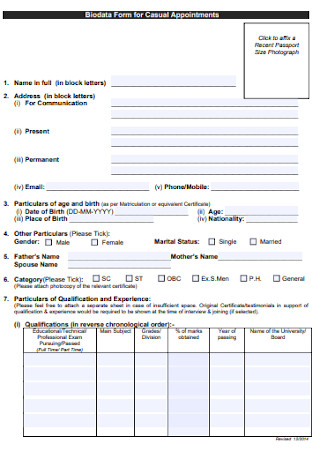
Biodata Form for Casual Appointments
download now -
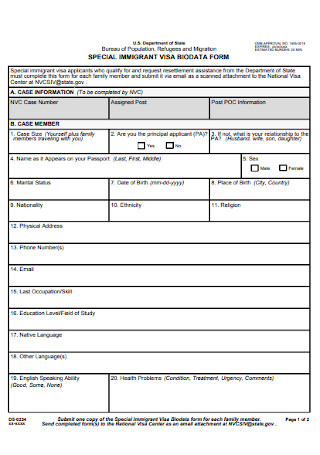
Special Visa Biodata Form
download now -
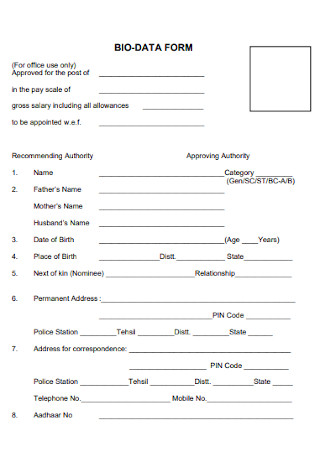
Biodata Form for Job Application
download now -
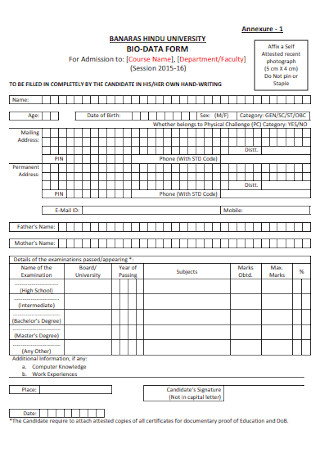
University Student Biodata Form Sample
download now -
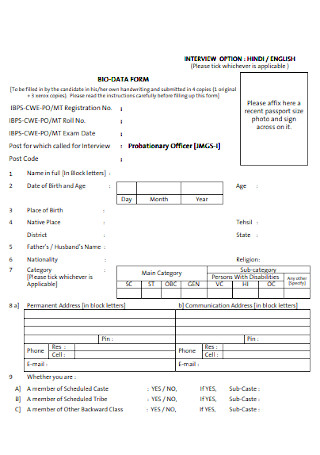
Sample Bank Biodata Form
download now -
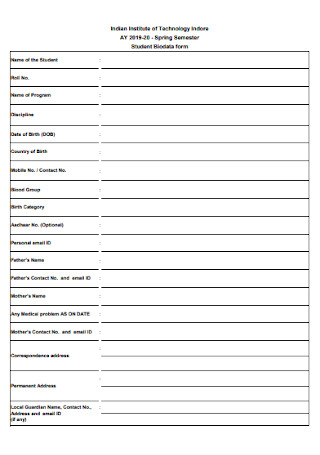
Personal Biodata Form
download now -
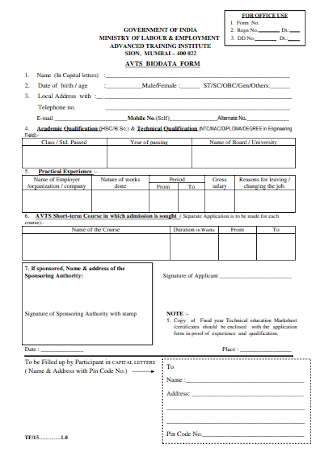
Employment Bio Data Form
download now -
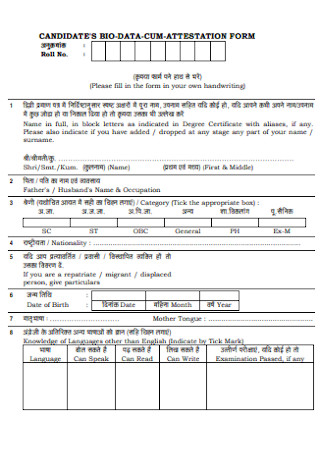
Candidate Bio Data Form
download now -
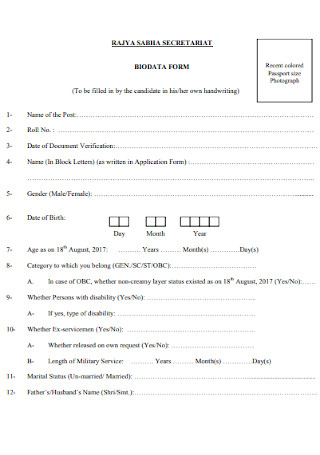
Simple Biodata Form Template
download now -
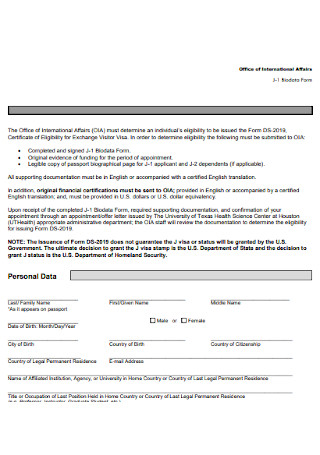
Biodata Form for Interview
download now -
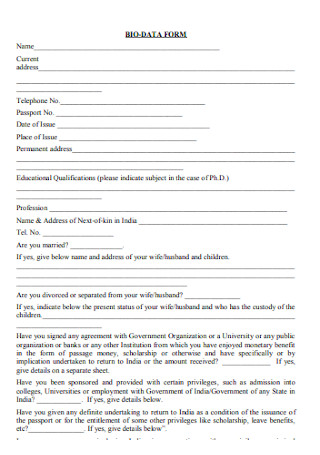
General Biodata Form Template
download now -
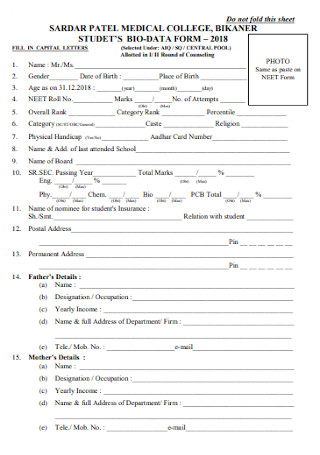
College Student Bio Data Form
download now -
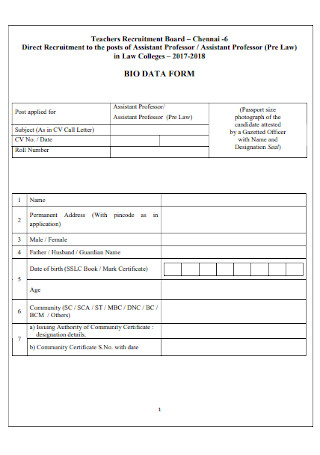
Teacher Bio Data Form
download now -

Bio Data Form for Employees
download now -

Biographical Data Form
download now -
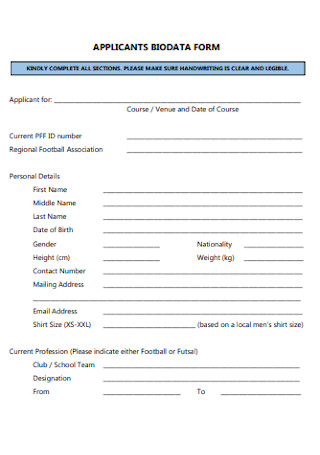
Applicant Biodata Form
download now -
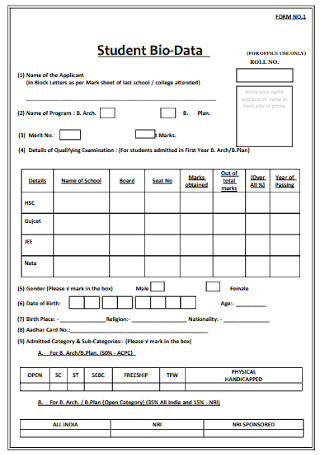
University Student Bio Data Form
download now -
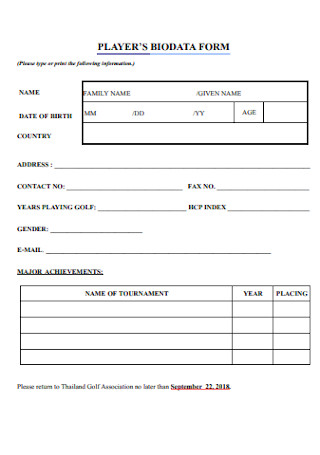
Players Biodata Form Template
download now -
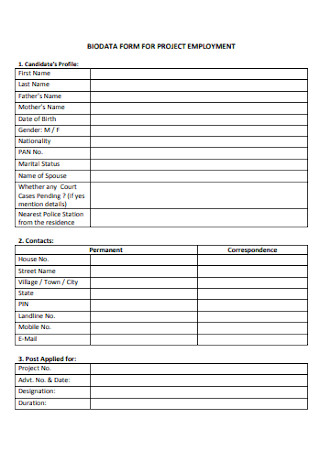
Bio Data Form for Project Employment
download now -
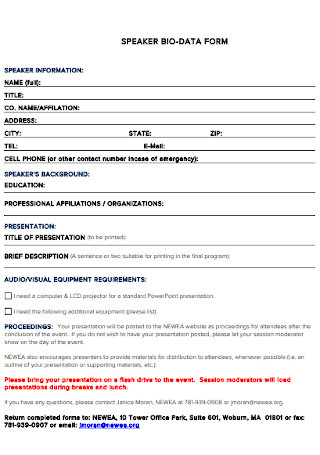
Speaker Bio Data Form
download now -
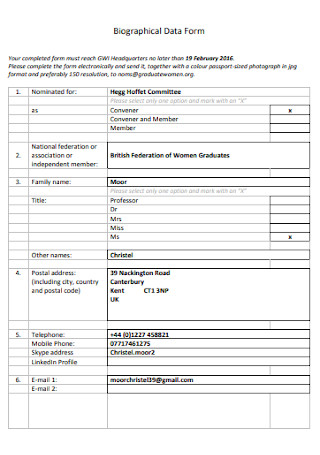
Family Bio Data Form
download now -
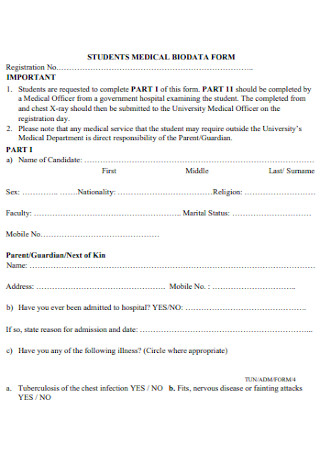
Student Medical Bio Data Form
download now -
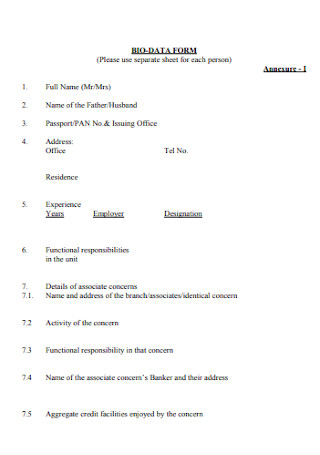
Standard Bio Data Form Template
download now -

Club Bio data Form
download now -

Formal Bio Data Form Template
download now
FREE Biodata Form s to Download
Biodata Form Format
Biodata Form Samples
What is a Biodata Form?
Biodata Checklist: What Are Asked in the Form?
What Are the Types of Biodata?
How to Create a Biodata Form
How many pages should a biodata have?
What is not a biodata?
How do I collect people’s biodata?
How Do I Create a Biodata Form?
How Do You Write Your Biodata?
Why is Biodata Important?
What are the Four Basic Contents of a Biodata?
How Do I Create a Biodata Online?
How Do You End a Bio?
How Do I Add a Job to Biodata?
Is Biodata the Same as Resume?
Is Biodata a Document?
What Should Be in Biodata?
Should Biodata Be in a Box?
How Long Should a Bio Be?
Is Declaration Needed in Biodata?
Is Photo Required in Biodata?
Biodata Form Format
Personal Information
- Full Name: [ ]
- Date of Birth: [ ]
- Gender: [ ]
- Marital Status: [ ]
Contact Details
- Address: [ ]
- Phone Number: [ ]
- Email Address: [ ]
Educational Background
- Highest Qualification: [ ]
- School/College: [ ]
- Year of Passing: [ ]
Work Experience
- Company Name: [ ]
- Role: [ ]
- Duration: [ ]
Skills
- Skill 1: [Description]
- Skill 2: [Description]
References
- Reference Name: [ ]
- Contact Information: [ ]
- Relationship: [ ]
What is a Biodata Form?
A biodata form is a document that provides detailed information about an individual’s personal and professional life. It is commonly used in settings such as job applications, university admissions, and onboarding processes. The form includes fields for basic personal information, educational background, professional experience, skills, and sometimes personal interests or hobbies. This form serves as a standardized means for individuals to share their backgrounds in a structured and easy-to-review manner, aiding organizations in the selection and assessment processes.
Biodata Checklist: What Are Asked in the Form?
Indeed, the biodata form gathers your info. So what exactly are some of the things asked in that document? Remember that everything required to disclose in the form may vary. But, there are common factors realized in any basic biodata. And in this section, we will give you a checklist on the typical factors asked from a biodata form.
What Are the Types of Biodata?
Biodata can be used for various functions. And it only makes sense that there are different types of biodata too. Generally, there are five main categories of biodata—personal, job, medical, educational, and marriage biodata. What are they? And how do they differ from each other? Without further ado, here are the types of biodata:
Personal Biodata
From the name itself, personal biodata involves personal information of an individual. And this example is the most common type because the biodata serves its purpose, which is for profiling. This sheet can also be considered as general biodata since it can work for most applications. While this type is an all-purpose biodata or mostly for personal use, please don’t assume that it will be the same as what businesses or institutions require. You may also see Customer Service Resume
Job Biodata
Statista’s research survey confirmed that around 130.6 million of US citizens were employed full-time in 2019. Do you think employers with a hundred employees can memorize all the personal info of each worker? Of course not. Hence, job or employment biodata exists to collect all the employee details. Personal details highlight more on skills, professional competencies, and more job-driven data. But, job biodata is more formal than personal biodata. You may also see College Student Resume
Medical Biodata
Hospitals and medical services may seek medical biodata. Expect a person’s medical information to be the main focus of this type. Examples of what to ask include genotype, allergies, rhesus factor, disabilities, and other health conditions. And if there are confidential health matters recorded in the biodata, a confidentiality agreement is often at work. You may also see Acting Resume
Educational Biodata
In America, approximately 56.4 million students would attend the elementary, middle school, and high school in fall 2020. And just like employment, it won’t be easy to keep track of every person’s background. Thus, schools require educational biodata from all students for compliance. Educational history, awards, and certifications are often tackled here too. You may also see High School Resume
Marriage Biodata
As mentioned before, South Asian countries commonly use the matrimonial biodata or resume. And the marriage biodata form can ask plenty of elements regarding the married partners’ names, contact info, and more. Pictures are even required to provide each person’s face shape, height, weight, or complexion. Also, the form may incorporate lifestyle descriptions. You may also see Dot Form
How to Create a Biodata Form
You already learned the biodata form’s meaning, importance, common elements, and types. So, you are more than ready to make the biodata form itself. And it is not even that difficult as you download from our collection of downloadable and printable biodata form templates. All you have to do is choose a template, download, and fill in every blank to complete the form. And if you want to make a simple biodata into an excellent one, we got you covered. Follow these easy steps on how to create the biodata form:
Step 1: Determine the Biodata’s Purpose or Type
Yes, you plan to make a biodata form. But what is it specifically for? For employment, education, or maybe marriage? Recall those types of biodata discussed earlier to finalize the purpose. That way, you will already know what labels to set and how the format should be since you will base the form’s result according to its type or purpose. You may also see Construction Waiver Form
Step 2: Insert the Necessary Elements to Ask
Next, review the common elements asked in a biodata, as previously discussed. This step means you indicate the elements like the name, address, birth date, and more in the document. And just like questionnaires, include the blanks or boxes where applicants will provide their data. Be sure to pick the vital and relevant elements only because it is useless to add unnecessary info while forgetting the essential ones in the biodata. You may also see Construction Proposal Form
Step 3: Organize the Elements According to Categories
The biodata should not be littered with all the elements to ask without any organization. There should be clarity in the presentation and arrangement, as well. An example is to create categories. You could put the name, age, birth date, and the like under the “Personal Background” category. Next, you place the job-related elements under the “Employment Record” category. Continue the rest for educational background, character reference, and more. You may also see Delivery Note Form
Step 4: Provide Clear Instructions
Note the instructions for applicants when they fill out the biodata form. That way, no applicant will have to use the form wrongly. Maybe some people get confused about where to input particular information. And if some questions have options, others might wonder if their chosen answers should be encircled, underlined, or checked. So, guide applicants right from the get-go to the finish by incorporating clear instructions. You may also see Receipt Form
How many pages should a biodata have?
A biodata usually has a single page, but sometimes it could reach up to three pages. And the number of pages depends on how many details are required from the form. You may also see Nomination Form
What is not a biodata?
Biodata forms may ask for various information. A biodata doesn’t ask for anyone’s bank accounts, passwords, and other sensitive or personal account details. Otherwise, scams are bound to happen. You may also see Quotation Form
How do I collect people’s biodata?
There are plenty of ways available on how to collect people’s biodata. And the basic three to gather biodata are through paper forms, online sheets, and interviews. You may also see Scholarship Application Form
How Do I Create a Biodata Form?
Creating a biodata form involves designing a structured format to collect essential personal and professional information effectively.
- Define Purpose: Understand the purpose of the form, whether it’s for employment, education, or another specific use like a HR Form.
- Choose Fields: Include necessary fields such as name, age, education, and work experience.
- Design Layout: Design a user-friendly layout that is easy to fill out. Consider using a Data Entry Form format for clarity.
- Include Instructions: Provide clear instructions on how to fill out the form to avoid errors and incomplete information.
- Test and Revise: Test the form internally to ensure all questions are clear and the form functions as intended. Make revisions as necessary. You may also see Order Form
How Do You Write Your Biodata?
Writing your biodata effectively can help present your personal and professional qualifications in a compelling manner.
- Personal Information: Start with your name, contact information, and other relevant personal details.
- Educational Background: List your educational qualifications, including institutions attended and degrees earned.
- Professional Experience: Detail your work history, including job titles, responsibilities, and achievements.
- Skills and Competencies: Highlight specific skills and competencies that are relevant to the opportunity.
- Personal Interests: Optionally, include personal interests or hobbies that may enhance your application or relate to the role. You may also see Consent Form
Why is Biodata Important?
Aside from being a replacement to your CV or Sample Resume, biodata has a bunch of important functions. One example is for evaluation. The factual information about your profile is collated in the biodata. So when you request or apply for something, the bits of details from the form will serve as criteria in profiling and evaluating you. That reason explains why lots of applicants for employment are asked to submit the biodata for compliance. And once employers learn and compare each applicant’s background, it will be easy to choose who deserves to fill a position in the company.
Besides a job application, biodata forms serve as marriage requirements. India, Pakistan, and other South Asian countries even arrange the matrimonial biodata to assess if a person is appropriate to be someone’s lifetime partner. Hence, the form may gather as many details as it can get, including eye color, hobbies, likes, dislikes, and more. But, the biodata is tailored according to categories and format instead of just enumerating fact after fact. And it depends on whoever prepares the biodata form of how much data the document should collect. You may also see Job Application Form
Biodata is crucial as it provides a standardized set of information that can be used to evaluate candidates objectively.
- Screening Tool: Acts as a first screening tool in processes such as job applications or academic admissions.
- Profile Building: Helps in building a comprehensive profile of the individual for assessment.
- Comparison Basis: Provides a basis for comparing multiple candidates on a uniform set of criteria.
- Record Keeping: Serves as a record in personal files for future reference.
- Decision Making: Assists decision-makers in shortlisting candidates based on documented evidence and qualifications. You may also see Application Form
What are the Four Basic Contents of a Biodata?
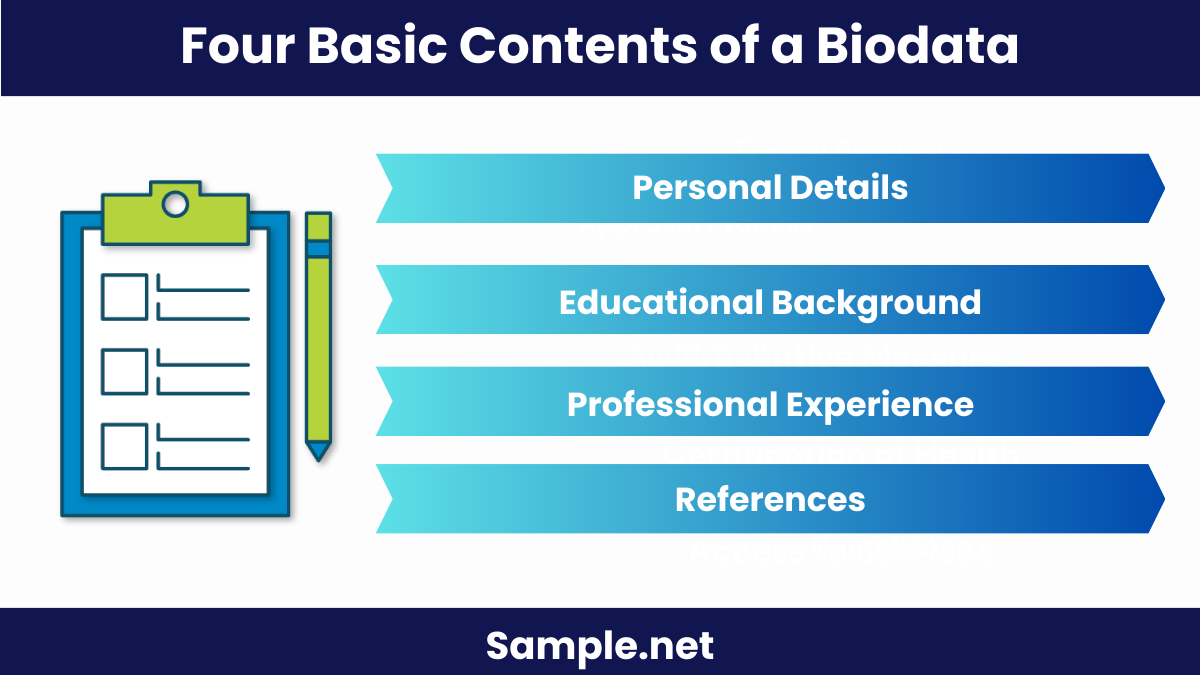
Biodata typically contains four basic types of information to provide a rounded view of an applicant.
- Personal Details: Includes full name, address, contact information, and sometimes marital status.
- Educational Background: Details of schooling, higher education, certificates, and special qualifications.
- Professional Experience: Information about past and current employment, including roles and responsibilities.
- References: Names and contact details of people who can vouch for the individual’s professional or academic competence. You may also see Loan Application Form
How Do I Create a Biodata Online?
Creating an online biodata can be efficient and accessible, allowing for easy updates and submissions.
- Select a Template: Choose from various online templates that suit the purpose of your biodata, like an Enrollment Form.
- Fill in Details: Enter your personal and professional details into the chosen template.
- Customize Design: Adjust the design and layout to make your biodata visually appealing.
- Review: Thoroughly review the biodata to ensure all information is accurate and well-presented.
- Download and Share: Download your completed biodata in a suitable format and share as needed. You may also see Registration Form
How Do You End a Bio?
Ending a bio effectively can leave a lasting impression, so it’s important to close with a strong statement.
- Concise Summary: Summarize the key points about your professional life succinctly.
- Future Goals: Mention your aspirations or what you’re looking forward to in your professional journey.
- Call to Action: Include a subtle call to action, like an invitation to connect on professional networks.
- Thank You Note: Optionally, end with a thank you note for the reader’s time and consideration.
- Contact Information: Provide contact details to encourage further communication. You may also see Feedback Form
How Do I Add a Job to Biodata?
Adding job details to your biodata is essential for reflecting your professional growth and capabilities.
- Job Title and Company: Start with your most recent job title and the name of the company.
- Dates of Employment: Include the start and end dates of your employment to outline your career timeline.
- Job Responsibilities: List your key responsibilities in the role to demonstrate your skills and experience.
- Achievements: Highlight any significant achievements or milestones reached during your tenure at the company.
- Skills Developed: Mention specific skills you developed or honed while in the position, aligning them with the requirements of the role you are applying for. You may also see Employment & Job Application Form
Is Biodata the Same as Resume?
No, biodata is broader, often including marital status and religion, unlike a resume, which is strictly professional and used in a Reference Check Form.
Is Biodata a Document?
Yes, biodata is a document that contains detailed information about an individual’s personal and professional life, similar to a Credit Card Authorization Form.
What Should Be in Biodata?
Biodata should include personal details, educational background, work experience, and references, akin to information on a Compensation And Benefit Form.
Should Biodata Be in a Box?
Yes, formatting biodata in a box format can help organize information clearly and effectively, similar to entries in a Risk Assessment Form.
How Long Should a Bio Be?
A bio should be concise, typically no longer than a short paragraph, making it as succinct as information on a Minor Child Power of Attorney Form.
Is Declaration Needed in Biodata?
Yes, a declaration is often required in biodata to verify the authenticity of the information provided, similar to a Authorization Form.
Is Photo Required in Biodata?
Including a photo in biodata depends on the cultural norms and specific requirements of the entity requesting it, like certain entries in a Delivery Form.
In conclusion, the biodata form is a fundamental tool in both academic and professional fields. It standardizes the process of gathering personal data for various applications, making it easier for institutions to evaluate candidates. Properly designed biodata forms not only streamline the data collection process but also enhance the decision-making process by providing comprehensive insights into candidates’ backgrounds. The effective use of biodata forms, including samples, forms, and guidance on completion, is crucial in any Personal Contract where accurate and detailed information is necessary for assessment and selection.

